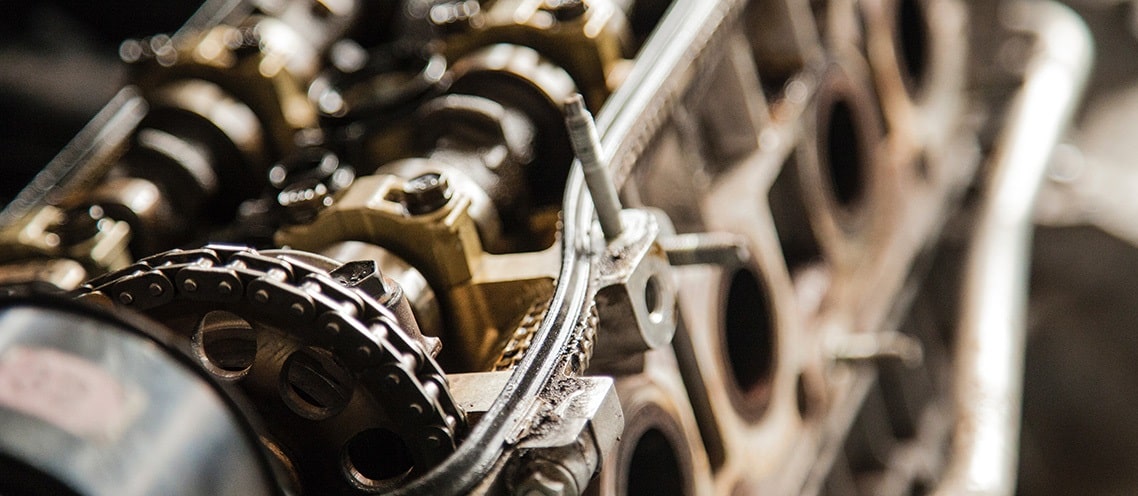GL4 vs GL5 Gear Oil: What Makes Them Different?
Before explaining the difference between GL4 vs GL5, we need to answer the question, “What is gear oil?” Gear oil is a specialized lubricant that helps maintain the performance and longevity of manual transmissions, differentials, and other gearboxes.
Some people refer to it as gear lube. Gear oil, or gear lube, comes in various viscosity grades. The American Petroleum Institute (API) classifies these grades based on the oils’ performance.
We will focus on two gear oils – GL4 and GL5 – because they’re the most common gear oils for high-performance, racing, and heavy-duty applications. There are other gear oil classifications, ranging from GL1 to GL3. But GL4 and GL5 are the most relevant for our discussion.
Choosing the right gear oil for your vehicle is essential because it maintains optimal drivetrain performance. It also helps your drivetrain components last longer.
Gear oils have different viscosity. An SAE 75W-90 gear oil is equivalent in viscosity to an SAE 10W-40 motor oil. Gear oils also have different additive packages, which is one of the things that differentiates between GL4 vs GL5 gear oil. We’ll discuss that in a moment.
Gear oil additives can affect the ability of your gears to transfer power. They can also help gears resist wear and damage.
The wrong type of gear oil can cause excessive wear on your gears and bearings. The result is premature failure and expensive repairs. The wrong gear oil can increase friction, reduce fuel economy, and damage your clutch if used in a manual transmission.
Using the wrong gear oil and viscosity in racing or heavy-duty situations can be harmful. You must choose the right oil to avoid problems.
This article will explore several gear oil topics, including:
- The differences between GL4 vs GL5 gear oil.
- How they rate gear oils.
- Where you would use a GL4 vs GL5.
- What is hypoid gear oil.
- What is limited slip gear oil.
American Petroleum Institute
The American Petroleum Institute (API) is a trade organization. It represents the oil and natural gas industry in the United States. API does many things, like creating guidelines and standards for different industry products. One of those products is gear oil.
The API classifies gear oils using a system of GL ratings, ranging from GL1 to GL5. These ratings provide information on the performance level of gear oils and help you select the right product for your specific needs.
Gear oil needs to perform better when used in more demanding conditions. A higher GL rating means that the oil has to work harder and can handle more severe conditions, like racing. The API GL ratings help you understand the performance ability of different gear oils.
Gear oil manufacturers recognize and trust API’s GL ratings as the industry standard. The same is true for vehicle and equipment manufacturers and end-users.
Different Gear Oil Ratings
As we mentioned, gear oil ratings vary. For example, they design GL1 gear oil for automotive spiral bevel and worm gear applications with low stress and low to moderate temperatures. An example is older vehicles with a simple, manual transmission. Think of GL1 as a basic gear oil for light-duty applications.
But GL5 gear oil is for hypoid gears that work under high stress and temperatures. An example is modern vehicles with high-performance axles. Think of it as a high-performance gear oil for heavy-duty applications.
Here’s another way to look at it. GL1 gear oil is like standard car motor oil, while GL5 gear oil is like high-performance motor oil for race cars. You wouldn’t use standard engine oil in a race car, and you wouldn’t use GL5 gear oil in a light-duty gear system.
Again, you must use the correct gear oil for your particular application. You can damage your gear system if you don’t.
Extreme Pressure Additives
The difference between GL4 and GL5 gear oils is in the amount of extreme pressure additives, or EP additives.
GL4 gear oils may contain up to 4.0% effective anti-scuffing additive. What is GL5 gear oil? It contains up to 6.5% anti-scuffing additive. Extreme pressure additives protect gears by providing a sacrificial layer on the gear surfaces.
Whenever two gears are together (in mesh), they push hard against each other. This pressure can cause metal-to-metal contact and wear if they’re not protected.
As a rule, extreme pressure additives contain compounds such as sulfur and phosphorus. These compounds have a higher shear strength than the metal surfaces they protect.
EP additives form a layer of sulfides and phosphates (sacrificial layer). Thus, they can handle extreme pressure and stress from your gear system.
They also act as anti-wear agents, reducing friction and wear between the gears. That’s critical in high-load/high-speed applications. Why? Because these applications subject gears to high stresses and wear.
To summarize, extreme pressure additives protect gears in high-stress applications. The sacrificial layer on gear surfaces reduces wear and friction. Extreme-pressure additives help extend gear life and improve the performance and efficiency of your gear system.
Where To Use GL4
Where is GL4 gear oil used? They make GL4 for spiral bevel and hypoid gears in car axles. It’s also used for spur and helical gears commonly found in manual transmissions and transaxles.
These gears operate under moderate speeds and loads. An example is an older vehicle with a simple manual transmission.
An older vehicle with a simple manual transmission has moderate gear performance requirements. It doesn’t need the highest amount of extreme-pressure additives. A GL4 gear oil works great in this case.
They make GL4 gear oils with enough EP additives to protect spur and helical gears in manual transmissions. A GL4 will maintain the necessary balance of viscosity, detergency, and corrosion protection.
This type of oil is perfect for vehicle gear applications with high levels of yellow metals. An API GL5 gear oil has higher levels of active sulfur phosphorous, which will corrode yellow metals.
Where To Use GL5
They design GL5 gear oils for hypoid gears found in automotive axles. These gears get subjected to high-speed, high-load conditions and need more EP protection than spur and helical gears. You’ll find hypoid gears in modern vehicles with high-performance axels. The higher amount of EP additives in GL5 gear oil meets the requirements of these gears.
A GL5 gear oil has about twice as much EP additive as a GL4, ensuring the greatest protection, performance, and efficiency for your hypoid gear system.
Don’t use a GL4 gear oil in a hypoid gear system. It can not only reduce performance but also damage your gears.
To conclude, GL4 and GL5 gear oils are for different types of gears and performance requirements. Make sure to use the proper kind of oil for your application. You should consult your owner’s manual for the manufacturer’s gear oil recommendation.
SYNTHETIC VS CONVENTIONAL GEAR OIL
How do you know whether to use synthetic vs conventional gear oil? What about semi-synthetic? There are a few things to consider. What type of gear system are you lubricating? They recommend full synthetic gear oil for high-performance and heavy-duty applications. Semi-synthetic gear oils are more for general-purpose use.
Also, what are the operating conditions of your gear system? Is it subject to high temperatures and high stress? If so, use full synthetic gear oil vs semi-synthetic. Racing and high-performance vehicles deal with high speeds and high loads. Those vehicles need full synthetic gear oil to meet their needs.
If you drive a regular car under normal conditions, use a semi-synthetic or conventional base gear oil.
It’s always important to consider the manufacturer’s recommendations for your specific gear system. Some systems call for a particular type of gear oil, like full, semi-synthetic, or conventional base. This allows for optimal performance and helps you avoid damaging the gears.
Choosing between a full, semi-synthetic, or conventional base gear oil depends. What are your vehicle’s specific needs? What is the operating condition of your gear system? Again, when in doubt, refer to your owner’s manual.
What Is Hypoid Gear Oil?
Hypoid gear oil is for hypoid gears, which are spiral bevel gears with non-intersecting, non-parallel axes. Hypoid gear oils have special additives, providing extreme pressure and anti-wear protection. They also have corrosion inhibitors to protect against rust and oxidation. You usually use hypoid gear oil in car and truck differentials.
What Is Limited Slip Gear Oil?
A limited-slip differential (LSD) is different from an open differential. An LSD uses friction plates, cones, or clutches that limit the amount of slip between the wheels. It provides improved traction and handling in a variety of driving conditions.
An LSD distributes power to the wheels with the most grip. Limited-slip gear oil helps these differentials maintain and enhance performance.
Vehicles with LSDs need limited-slip differential gear oil (noted by an “LS” on the label of VP gear oil).
Using limited-slip gear oil in high-performance and sports vehicles is common. The same is valid for off-road vehicles and trucks that tow or haul heavy loads.
LSDs require more precise, consistent friction between the clutch plates or cones than an open differential. Thus, they need a special gear oil containing friction modifiers. Friction modifiers help maintain friction consistency between the clutch plates or cones. The modifiers reduce the chatter that can happen when the LSD engages.
The Best Gear Oil for Your Vehicle
Naturally, you want the best gear oil for your vehicle. Using VP gear oil will help your gears perform better and last longer.
We design VP Racing gear oil from premium base stocks and advanced additives. Our gear oils keep your drivetrain running in top condition and protect critical internal parts in your gear system.
VP’s gear oil line includes two fully synthetic GL5 blends plus a semi-synthetic GL5 blend. We formulate two conventional gear oils. All VP API GL5 gear oils are limited-slip capable and for use in GL5 applications requiring limited-slip additives.
VP Racing Gear Oil Line
VP Classic SAE 80W-90 GL4 Gear Oil
- Contains conventional base stocks. Use it in classic manual transmissions with yellow metals & other soft metals, like brass, bronze, copper, and others.
- Recommended for use in traditional manual transmissions, like Rockwell, Muncie, Borg-Warner, Ford, & Saginaw.
- Great for synchronizers, thrust washers, bushings, and more.
VP Hi-Performance Full Synthetic SAE 75W-140 LS GL5 Gear Oil
- Contains synthetic base stocks with a high viscosity index; limited-slip capable.
- Formulated with extreme pressure additives + rust and corrosion inhibitors.
- Designed for high speed/high shock load & low speed/high torque conditions year around.
VP Hi-Performance Full Synthetic SAE 75W-90 LS GL5 Gear Oil
- Full synthetic, extreme pressure, limited-slip multi-purpose gear oil.
- Designed for high speed/high shock load & low speed/high torque conditions.
- Resists high temperature oxidation & deposits while delivering excellent rust & corrosion protection.
VP Hi-Performance Semi-Synthetic SAE 80W-140 LS GL5 Gear Oil
- Contains naturally high VI conventional base stocks with a synthetic component.
- Features extreme pressure additives plus rust & corrosion inhibitors.
- Recommended for heavy-duty axles and heavy-duty non-synchronized manual transmissions. It also works well with limited-slip differentials.
VP Hi-Performance SAE 80W-90 LS GL5 Hypoid Gear Oil
- Blended with high-quality conventional base stocks & unique extreme pressure additives.
- Provides outstanding load-carrying capability and anti-scuff, anti-weld, & anti-wear protection.
- Minimizes wear under high speed/high load & low speed/high torque conditions; limited-slip capable.
Give your vehicle industry-leading protection and performance. Find the blend that’s right for your application.

